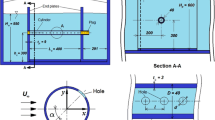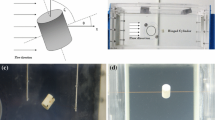Abstract
The flow over fixed, hollow, rigid circular cylinders with and without two series of equally spaced holes of equal diameter (0.2 cylinder diameter) along the surface of the cylinder has been studied by means of dye injection flow visualization, particle image velocimetry (PIV), and force measurements. Holes are connecting the front and rear stagnation lines or the upper and lower sides (i.e., they are positioned at ± 90° from the stagnation line) of the cylinder. The center-to-center distance between holes was 7-hole diameter. The experimental data were obtained from water channel and wind tunnel measurements performed at Reynolds numbers of 6900 and 20000, respectively. It was found that cylinder with holes located on the surface at an angle ± 90° from the front stagnation line behaves like a double-chamber synthetic jet actuator when subjected to cross-flow. The interaction of synthetic jet arrays with external flow over the side surfaces instigates the three-dimensional instabilities in the near wake and produces a 14.4% drag reduction compared to the drag of a plain cylinder. It was shown that cylinder with holes located on the surface at angles of 0° and 180° from the front stagnation line also instigates the three-dimensional instabilities in the near wake, but the primary mechanism responsible for drag reduction is self-bleed through downstream holes. This system producing drag reduction was found to have a drag coefficient equal to about 78.9% of that for a plain cylinder. Important flow structures inside and behind the cylinders with holes were also identified.
Graphic abstract




















Similar content being viewed by others
References
Alam MM, Sakamoto H, Moriya M (2003) Reduction of fluid forces acting on a single circular cylinder and two circular cylinders by using tripping rods. J Fluid Struct 18:347–366
Alam MM, Sakamoto H, Zhou Y (2006) Effect of a T-shaped plate on reduction in fluid forces on two tandem cylinders in a cross-flow. J Wind Eng Ind Aerodyn 94:525–551
Alam MM, Zhou Y, Zhao JM, Flamand O, Boujard O (2010) Classification of the tripped cylinder wake and bi-stable phenomenon. Int J Heat Fluid Flow 31:545–560
Alam MM, Elhimer M, Wang L, Jacono DL, Wong CW (2018) Vortex shedding from tandem cylinders. Exp Fluids 59:60
Bloor MS (1964) The transition to turbulence in the wake of a circular cylinder. J Fluid Mech 19(2):290–304
Baek H, Karniadakis GE (2009) Suppressing vortex-induced vibrations via passive means. J Fluid Struct 25:848–866
Bingham C, Morton C, Martinuzzi RJ (2018) Influence of control cylinder placement on vortex shedding from a circular cylinder. Exp Fluids 59:158
Clapperton BL, Bearman PW (2018) Control of circular cylinder flow using distributed passive jets. J Fluid Mech 848:1157–1178
Dong S, Karniadakis GE, Ekmekci A, Rockwell D (2006) A combined direct numerical simulation-particle image velocimetry study of the turbulent near wake. J Fluid Mech 569:185–207
Durhasan T, Pinar E, Ozkan GM, Aksoy MM, Akilli H, Sahin B (2018) PIV measurement downstream of perforated cylinder in deep water. Eur J Mech B-Fluid 72:225–234
Durhasan T, Pinar E, Ozkan GM, Akilli H, Sahin B (2019) The effect of shroud on vortex shedding mechanism of cylinder. Appl Ocean Res 84:51–61
ESDU 80024 (1998) Blockage corrections for bluff bodies in confined flows. Engineering Sciences Data Unit, London
Fırat E, Özkan GM, Akilli H (2017) PIV measurements in the near wakes of hollow cylinders with holes. Exp Fluids 58:39
Fu H, Rockwell D (2005) Shallow flow past a cylinder: control of the near wake. J Fluid Mech 539:1–24
Gao D-L, Chen W-L, Li H, Hu H (2017a) Flow around a circular cylinder with slit. Exp Therm Fluid Sci 82:287–301
Gao D-L, Chen W-L, Li H, Hu H (2017b) Flow around a slotted circular cylinder at various angles of attack. Exp Fluids 58:132
Gao D, Chen G, Chen W, Huang Y, Li H (2019) Active control of circular cylinder flow with windward suction and leeward blowing. Exp Fluids 60:26
Gerrard JH (1966) The mechanics of the formation region of vortices behind bluff bodies. J Fluid Mech 25:401–413
Geyer TF, Sarradj E (2016) Circular cylinders with soft porous cover for flow noise reduction. Exp Fluids 57:30
Igarashi T (1978) Flow characteristics around a circular cylinder with a slit (1st Report, Flow Control and Flow Patterns). B JSME 21:656–664
Jabbal M, Jeyalingam J (2017) Towards the noise reduction of piezoelectrical-driven synthetic jet actuators. Sens Actuator A-Phys 266:273–284
Lin J-C, Rockwell D (1997) Quantitative interpretation of vortices from a cylinder oscillating in quiescent fluid. Exp Fluids 23:99–104
Ma HL, Kuo C-H (2016) Control of boundary layer flow and lock-on of wake behind a circular cylinder with a normal slit. Eur J Mech B-Fluid 59:99–114
Marble E, Morton C, Yarusevych S (2018) Vortex dynamics in the wake of a pivoted cylinder undergoing vortex-induced vibrations with elliptic trajectories. Exp Fluids 59:78
Norberg C (1994) An experimental investigation of the flow around a circular cylinder: influence of aspect ratio. J Fluid Mech 258:287–316
Norberg C (2003) Fluctuating lift on a circular cylinder: review and new measurements. J Fluids Struct 17:57–96
Peng BH, Miau JJ, Bao F, Weng LD, Chao CC, Hsu CC (2012) Performance of vortex shedding from a circular cylinder with a slit normal to the stream. Flow Meas Instrum 25:54–62
Reichl P, Hourigan K, Thompson MC (2005) Flow past a cylinder close to a free surface. J Fluid Mech 533:269–293
Roshko A (1993) Perspectives on bluff body aerodynamics. J Wind Eng Ind Aerodyn 49:79–100
Samani M, Bergstrom DJ (2015) Effect of a wall on the wake dynamics of an infinite square cylinder. Int J Heat Fluid Flow 55:158–166
Schiller L, Linke W (1933) Druck- und Reibungswiderstand des Zylinders bei Reynoldsschen Zahlen 5000 bis 40000. Z Flugtech Motorluft 24:193–198
Wang XK, Tan SK (2008) Near-wake flow characteristics of a circular cylinder close to a wall. J Fluids Struct 24:605–627
Wang J, Wang C (2016) Heat transfer and flow characteristics of a rectangular channel with a small circular cylinder having slit-vent vortex generator. Int J Therm Sci 104:158–171
Wang XK, Zhang J-X, Hao Z, Zhou B, Tan SK (2015) Influence of wall proximity on flow around two tandem circular cylinder. Ocean Eng 94:36–50
Yajima Y, Sano O (1996) A note on the drag reduction of a circular cylinder due to double rows of holes. Fluid Dyn Res 18:237–243
Acknowledgements
The authors would like to thank Dr. Yahya E. Akansu for allowing us to use the wind tunnel facility in the Department of Mechanical Engineering at Niğde Ömer Halisdemir University.
Author information
Authors and Affiliations
Corresponding author
Additional information
Publisher's Note
Springer Nature remains neutral with regard to jurisdictional claims in published maps and institutional affiliations.
Rights and permissions
About this article
Cite this article
Firat, E., Ozkan, G.M. & Akilli, H. Flow past a hollow cylinder with two spanwise rows of holes. Exp Fluids 60, 163 (2019). https://doi.org/10.1007/s00348-019-2814-2
Received:
Revised:
Accepted:
Published:
DOI: https://doi.org/10.1007/s00348-019-2814-2




